I am not so sure that we are not missing something. It is easy to disturb a habitat and to send the population packing. It is quite another matter to actually locate just where the population ended up.
Birds in particular have great mobility. Worse, we think that we understand and even know our surrounds. Yet to inspect properly a single square mile of woodland within eyeball range would demand fiftly miles of dedicated walking mostly looking at negative data or nothing. The same holds true for a square mile of grassland. If anything it is worse as anyone who has lain down in such a field and rolled out a nest can affirm.
Today we have huge flocks neatly distributed in cities. This is superior to woodlots and often much better food supplies. who is counting them?.
Wildness on a Whim: Reflections on Whimbrel in the South Carolina Lowcountry
Essay by J. Drew LanhamWhim\(h)wim\ noun: a sudden desire or change of mind, especially one that is unusual or unexplained. Whimbrel by Andy Johnson.
October 13, 2021
Wildness is life lived on whim. It is the unpredictable spur-of-the-moment change or the chain of unlikely events fallen upon birds and beasts without restraint or barriers to keep them “safe” and under some semblance of control. If wildness were a mood (which I believe isn’t too much to ask), it would be the ficklest: joyous one moment in the American Goldfinch’s late-summer, song-spangled, bounding flight; melancholy lovesick blue in a Wood Thrush deep-woods solo; and then bare-tree sullen in the Barred Owl’s dim-lit winter bottomland bawl.
Wildness is in landscapes far flung from wherever our comfortably close might be. Gyrfalcons on windswept tundra come to mind. Or close by—the migrating Yellow Warbler flitting in the backyard, whose sudden decision to jump and cross the Gulf of Mexico in the dark, escaping predator and weather in ceaseless wing-beating migration that led to it being within arm’s reach, is whim. Its singular choice is miraculously calculated as the sum total of millennia of adaptive pressures, differential survival, and reproduction. That moment of lifting off from the Yucatan bump to go north, or make the return trip south from some willow thicket that led to a bird-beak-to-human-nose encounter, was triggered in ways we can never fully know. For the warbler and the noticer, whim is life being left to random acts that could mean seeing or not being seen. Whim means thriving one moment and dying the next. Whim is being in the midst of the miraculous in some ordinary space. Whim is the unpredictable multiplied by the improbable raised to the power of chance.
That the unpredictable linkages between what we can control and cannot; between causes and effects; between us human-kind and them, wild birds—whether on a remote wilderness trail, or in a city park down the street—often happen in an amorphous cloud of best guesses (science) and serendipity (luck) is job security for those of us tasked with the science, and inspiration for those of us envying flight and freedom. For me it is both.
My mind is bent to these kinds of gyrations more than not; stretching words to fit meanings I feel more than think. But it wasn’t a wild place at all that set so much of my wild thinking in motion recently. Instead, it was a mishmash of seemingly random events, converging over a half-dozen years—including the horrific 18 months and counting of pandemic—connected through strangers met by chance, spurred on by whim doubly defined, and all converged on a spit of sand to bring much-needed good news in a troublesome time.
South Carolina poet and ornithologist Dr. J. Drew Lanham reflects on the Deveaux Bank Whimbrel roost as a foothold for a new kind of hope — not only for ecological recovery, but for redemption and repair in a landscape torn apart by slavery.
This is a story that began in 2014 with a journey to a place I knew of but had never been: a Lowcountry South Carolina island (once plantation) called Seabrook. It is a place haunted by chattel enslavement of Black people bound to indigo, to Carolina gold rice, and to sea-island cotton. It is a place now transformed by wealth and appropriation to mostly homogenized luxury living. The kind favor of a friend had us visit on the back end of 2014. Although we’re more an Edisto Island family, it was another chance to gather on the coast.
Now, the irony of my middle-class Black family seeking time in the midst of so much complexity isn’t lost on me. Charleston is the historic epicenter of American slavery, with the largest proportion of enslaved Africans stepping ashore in its harbors. From there, America grew rice grain by rice grain, cotton boll to bale. Our annual visits to Edisto Island are a part of the duality—bound to history and traveling now by choice. By my figuring, it’s a way of reclaiming part of what was taken away. Not the full 40 acres or the mule, but something that gives me joy. And there are birds down there I can’t see in my upstate Upper Piedmont near Blue Ridge Mountain home. Swallow-tailed Kites, Roseate Spoonbills, Black Skimmers, Brown Pelicans, Painted Buntings—the list of birds that I can see before midmorning without much more than a step into some nearby wildlife management area is mind-boggling.
To see these birds on a Lowcountry dawn with the sun rising up out of the Atlantic never ceases to inspire me. The birds and wildness would be enough for most. But for me there are other stories to experience that bind me to these places like a tick to exposed skin. There’s a history of my ancestors and bondage that isn’t ignorable. And so I immerse myself in birds, Black history, and wildness. The three braid themselves in and out of my being, one subject interjecting itself into some wondering without warning, causing thoughts in my brain to murmurate. I suppose one might call that whim.
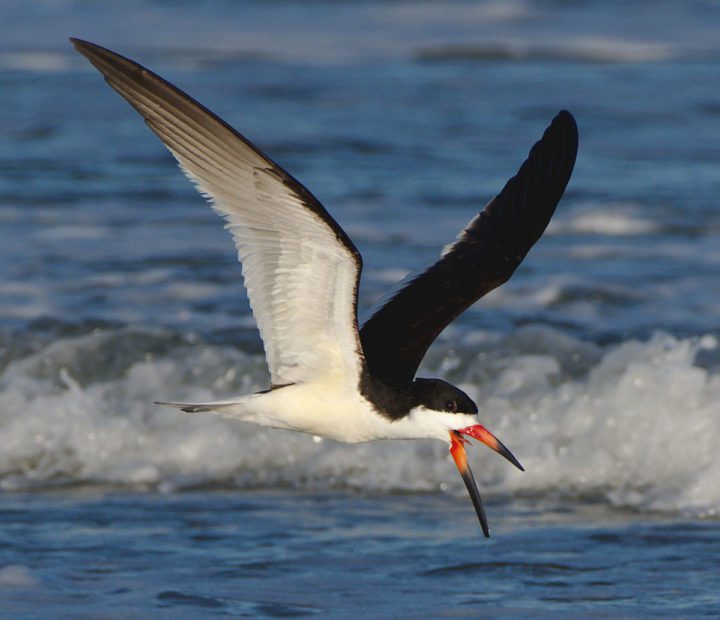
Black Skimmer at Seabrook Island, South Carolina. Photo by Carl Miller/Macaulay Library.
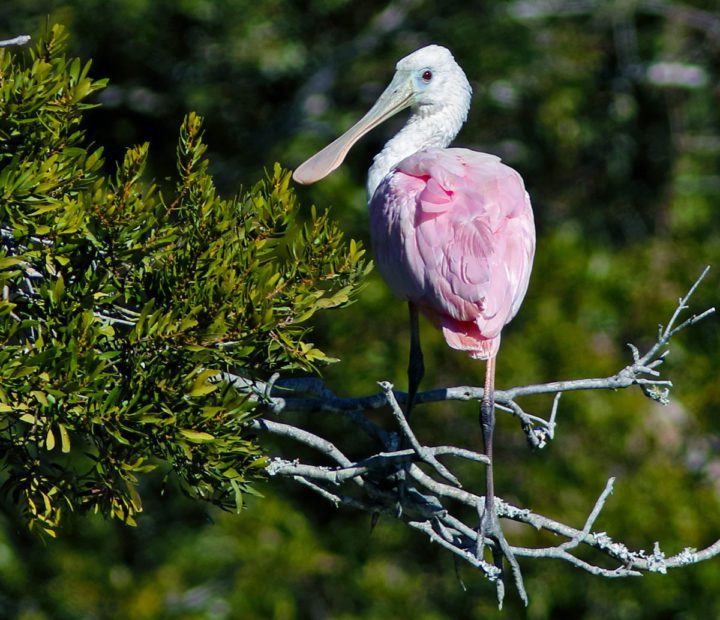
Roseate Spoonbill at Seabrook Island, South Carolina. Photo by Robert Mercer/Macaulay Library.
On the third day at Seabrook, I headed out early to check the low-tide offerings. There were gulls. Lots of gulls. A few Fish Crows deny everything, their anh-anh calls definitive. I had my scope on one shoulder and binoculars slung on the other. I needed to make sure people there saw me as a birder, and not someone that needed a security call to the police. I eased into watching the queues of Brown Pelicans floating up and down the beach. Sanderlings skittered in the breaking waves. Ahead, a small flock of shorebirds approached, flew past me just offshore, then wheeled in a singular pirouette to land a hundred yards away. Red Knots, 20 or so of one of the most familiar but most precipitously declining shorebirds, were picking about on the wrack line of flotsam left behind.
I was alone with the birds for most of the morning when a woman who looked more casual beach stroller than concerned birdwatcher approached me: “Good morning! What are you seeing?”
I re-tensed a bit, not quite ready to be personable but aware that my Blackness, in this very white place, was always being watched.
“Hey! Just checking out this flock of Red Knots that just flew in,” I replied. “Nice to see them here.”
It was a short enough explanation with bird IDs dropped in so she’d know I was someone to take seriously—and without a threat. We talked birds for a while as I ran my morning list down to her. She introduced herself as Sue and I, in my introduction, made sure to drop my university credentials.
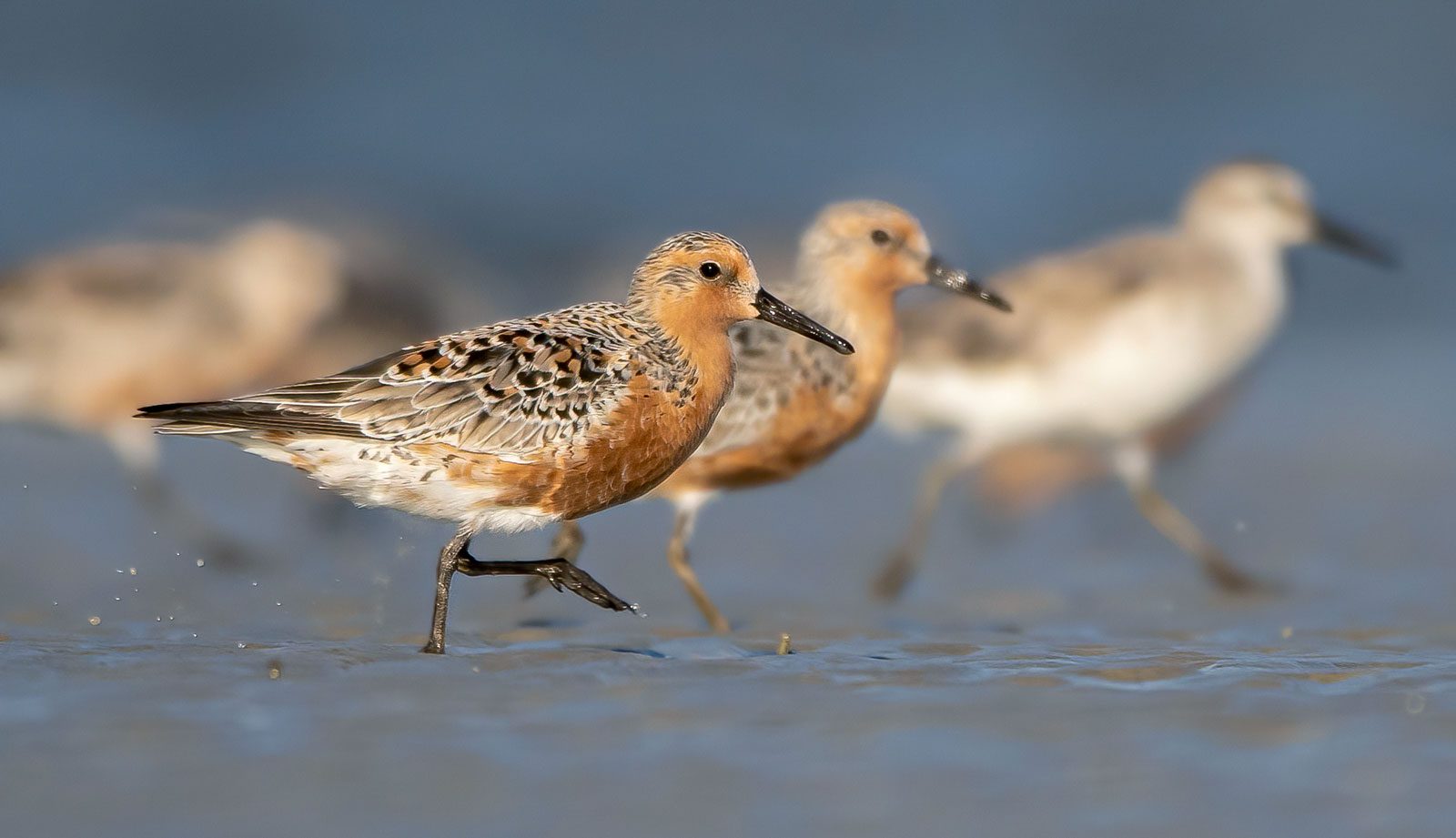
Red Knots in South Carolina. Photo by Matthew Plante/Macaulay Library.
“I’ll tell my son I met you,” Sue said. “He’s studying birds himself and would love to meet you. Maybe you two could go birding?”
“Sure thing!” I said, without much thought on just who this young bird person might be. I’d just met this woman on the beach and now I was agreeing to extend the bounds of space and time to another stranger. But then I didn’t really expect her to follow through. I meet lots of people who feint at further relationship, but then most of the time contacts get lost, time passes, and we never meet again. I watched the knots for a few minutes after Sue departed and didn’t give further encounters much thought.
Later that day as my family jigsaw puzzled, watched bowl games, and snacked our lives away, a knock came at the door. An auburn-haired early-twenty-something stood there.
“Hi…Dr. Lanham? I’m Andy. Andy Johnson. You met my mother earlier today out on the beach and said there were Red Knots out there. She told me you said it was okay if I dropped by.”
He was confident and straightforward. Andy stepped into the house and my life, a stranger I’d only just met but whose mother I’d somehow trusted enough to give an open invitation to. We talked for a while about the knots and Andy confirmed his ornithological aspirations. A young undergraduate at Cornell, he knew things only a deeply steeped birder would know.
“Yeah, those birds are probably coming over from Deveaux Bank,” he said. “It’s right off the shore where you and my mom were. I’d bet anything they’re going back and forth between there and here.”
Now I knew of Deveaux Bank, a relatively tiny spit of land that held high value for breeding shorebirds and seabirds. But in my time on Seabrook in the midst of everything manicured just-so, I’d not thought of this island of faraway-feeling wildness being so close as to share its birds with me. I told Andy of my Cornell birdman dreams as a kid and how I envied his opportunity to study at the mecca of American ornithology. We tried to arrange a time to bird but our schedules wouldn’t jibe. We exchanged numbers and promises to reconnect. I’d had many such meetings with strangers over birds and counted this one in the litany of pleasant singular encounters.
Whimbrels flying at Deveaux Bank. Photo by Andy Johnson.
Sitting in my university office in the spring of 2019, five years past that winter’s week at Seabrook, I’m not puzzling probabilities of chance meetings but trying to stem the overflow of email screaming “RESPOND!” and procrastination coming due at the beginning of the semester. I scroll through all but the most threatening messages, but then there’s one so seductive I can’t let it go. I even scroll through it at first, intent on leaving it for a proper in-depth response later as I’m on the edge of overwhelm. It’s a constant triage situation, but the subject line—“Whimbrel Interview”—called to me. In the midst of everything I was behind in, I opened it.
Whimbrels, the stocky curlews I know best from my time on Edisto Island’s Botany Bay Wildlife Management Area, were worthy of the pause. There, at my virtual door with Whimbrel as bait, stood Andy Johnson, Seabrook Island Cornell bird guy all grown up, now a Cornell Lab of Ornithology multimedia producer. His email read:
Dear Drew,
I wanted to get in touch about the idea of getting your perspectives on a new Whimbrel roost that Felicia and team recently discovered. It’s a wonderful story in your backyard, but one that’s still under wraps for the time being. We’re planning to be in South Carolina for late April and May to film again at Deveaux, but also trying to squeeze in a trip during the first week of March (obviously rapidly approaching!) to record some interviews in advance…
A new Whimbrel roost? On Deveaux? That any place holds such promise as a refuge for so many imperiled birds was miraculous. That it was on a comma of sea soil giving the Whimbrel a place to pause just a few miles south of Charleston, and on the hardening edges of so much development, was almost unbelievable. I’m not sure I’d ever even imagined where the dozen or so Whimbrels I ever saw on any trip to the coast went when they flew out of my binocular view. But that a little spit of sand was a refuge for a favorite bird was cool enough, and not so surprising given Deveaux’s critical role as a shorebird and seabird sanctuary. I knew Felicia Sanders as a bird conservation hero in South Carolina, a state DNR wildlife biologist protecting places all over the Palmetto State coast. To speak to her discovery would be fun, I thought. With a few calls afterward and a date set for him to come to my office in the Clemson Department of Forestry and Environmental Conservation, the Andy Johnson Whimbrel meeting-to-come slipped once again onto my to-do-later list. I really had no time for whim or any more Whimbrels at the moment, or so I thought.
But Andy didn’t forget. A few weeks later he was at my door again. This time in the flesh. I was still distracted with work overwhelm but there was something about Andy’s persistent pleasant urgency that settled me down. We rehashed our first meeting on how fast the time had passed. Where I’d met Andy’s mother and scoped the Red Knots was the baseline for what was about to be revealed.
“I think that perhaps we’ve found—Felicia Sanders has discovered—the largest Whimbrel roost on the East Coast, possibly in the Lower 48. She was out on Deveaux and got caught out there one night on a high tide and all of these birds starting coming in. Thousands of them.”
Andy was excited. I could see it in his eyes. Heard it in measured excitement. I sat listening, increasingly less concerned with whatever I needed to do, nodding, smiling; happy to be “in” on the secret of something I wanted to do.
“Maybe it’ll be best to show him,” Jonathan, his partner on the filming project, said. Andy agreed, and opened a thumb drive file on my large desk computer screen. What he’d told me in a few words unwrapped itself in high-def gold-suffused light. I squinted into the screen; my head propped in my hands. Right there, on my desk, were more Whimbrels in a single frame of video than I’d seen my whole life. There were shots of flocks of hundreds. Then thousands. Whimbrels flew in against the setting sun, in and out of well-framed marsh shots they came and went. Whimbrels walked about on the surf-packed sand. I couldn’t count them all. I couldn’t speak more than a word or two with the tens of thousands of birds flooding in front of me, either. I smiled and then a few tears welled up.
“This is on Deveaux?” I asked.
“Yep, Deveaux Bank,” Andy said.
I stumbled over disbelief, then found joy. I still couldn’t find words, though. So it was the perfect time, I suppose, for Andy to begin his interview with me. No, I hadn’t been there for the discovery, but Andy knew my ties to the Lowcountry, its bittersweet history and how birds tied it all together—like Bobolinks to rice culture to Black people to Black Rails and Black Ducks.
“Andy wanted me to see the spectacle for myself…. I said ‘yes’ on a whim.”
I spoke as best I could to what I’d seen virtually, grateful for the opportunity to speak on behalf of the convergences between abundant wildness so close to Charleston’s burgeoning, and what I called the “Nearby Faraway.” I kept feeling a circle closing and widening at once. The chance meetings. The timing. The intersections of probabilities and possibilities. None of this had been planned, but now planning was required.
Andy wanted me to see the spectacle for myself in the coming spring of 2020. It had been six years since our initial Seabrook connection, with more gaps than connects since. That didn’t matter. There was something deeper linking us together. With no idea of what other schedule I might be stepping on, I said “yes” on a whim.
Photo by Andy Johnson.
Pandemonium doesn’t make plans. It crushes them and operates on the worst kind of whim. Destruction and death are its calling cards. By March of 2020 the world felt fractured and ever fractioning under the compounded stress of pandemic, racial injustice, and political upheaval. My upstate backyard was one of the few places I felt somewhat whole. It became a refuge from the consistently bad news.
The visit to Deveaux fell apart just as almost every other plan did. With quarantine and time at home, I waited on the first wave of Neotropical migrants to arrive. I filled the feeders in anticipation of Rose-breasted Grosbeaks and kept vigil for whatever drifted through the three-quarters of an acre. Each day the species list grew with swifts, warblers, grosbeaks, vireos and thrushes, bringing their tropical world northward. I absorbed every bird I could see or hear. It was the faraway brought nearby. Summer came and the breeders settled in. Then the migratory cycle turned with a cool rain on a mid-October afternoon that brought a mini-fallout of warblers, vireos, and thrushes, taking turns at overripe purple fruit and whatever insects loitered in the same pokeberry bush. It was a gift brought on a capricious wind. Wildness on the weather’s whim. Although those early days of plague taught me to appreciate the birds that came close in, I still wondered what I was missing in the faraway places I was used to visiting.
As the birds turned south with the coming autumn, so did I. Having dumped a sizable sum of nonrefundable money into the Edisto vacation rental, I pushed our time from August into by the fall. We took a measured escape and quarantined ourselves for two weeks with enough provisions to be satisfied and safe. My relief wasn’t inside, though. I took walks on the beach and almost daily trips to Botany Bay. I’ve always cherished the socially distant time at sunrise anywhere, but on Botany it is worth the extra-early awakening. It is one of the wildest places I know, with expanses of saltmarsh punctuated with mudflats and bracketed by copses of maritime forest. The open muddy ground teems with tens of thousands of thumbnail-sized fiddler crabs, each scuttling between one burrow and the next. Oysters audibly “pop” as the brackish water ebbs and flows. The spartina shimmies in the slightest breeze, and in October there are swatches of goldenrod and aster that splash yellow, white, and purple against the canvas of sky blue, marsh-grass green, and pluff mud-gray brown.
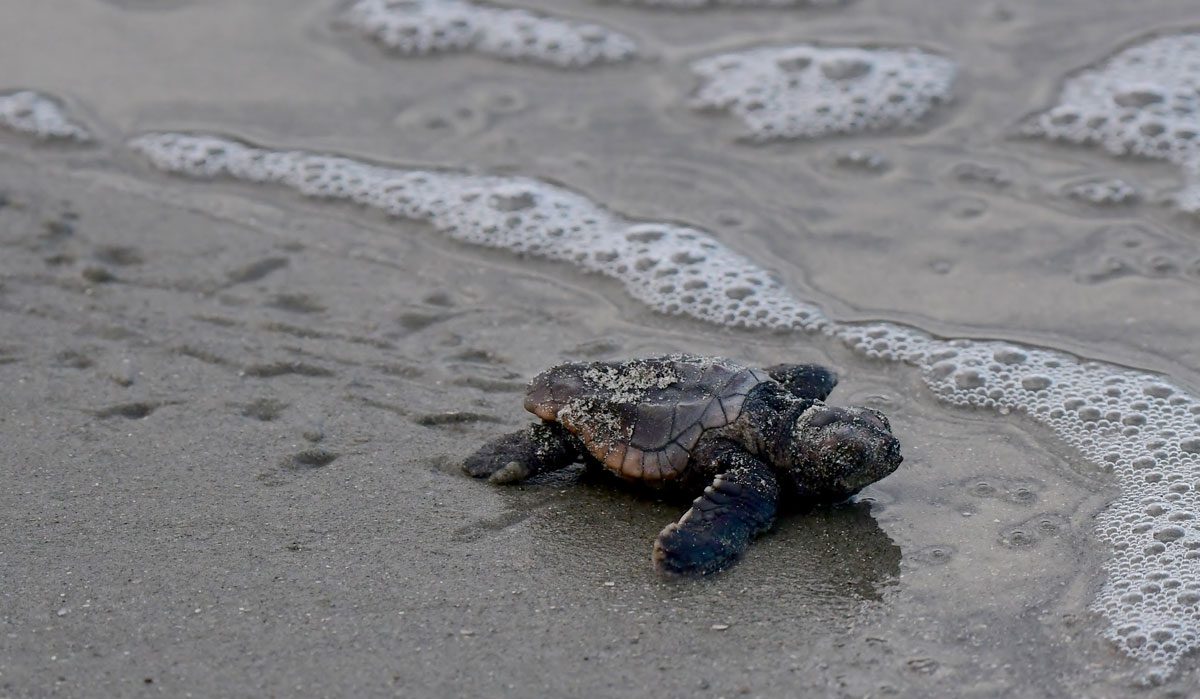
A newly hatched loggerhead sea turtle makes its way to the ocean in South Carolina. Photo by W. Gareth Rasberry/Wikimedia Commons.
I’m alone most of the time on these forays out to the boneyard beach, a coarse sandy crescent giving itself up to the Atlantic, where the dead hulks of sea-salt-strangled trees litter the shoreline. The beach is a favorite loggerhead sea turtle nesting site. Human visitors, prohibited from removing the beach’s abundant whelk shells, hang them instead on the dead trees, hitching them to knobs and spikes as if to claim the unclaimable. The quarter-mile walk from the parking area is meditation as much as path to destination. Great Egrets and Tricolored Herons pose reliably for pictures. In the summer and early fall, the hammocks are a lock for Painted Buntings. Pelicans and Royal Terns are common as robins. All of these are birds that I can see reliably here, but I know I can find elsewhere. The mudflats, though, usually hold something unique—Whimbrel.
Never more than a few birds, I’ll see them walking stout-legged and stripe-headed, picking off the fiddler crabs as eight-legged snacks. Ever wary, one or two always seem to have their heads up, scanning for danger. Sometimes I’ll catch a small flock coming in from the east, their long necks attenuated into elegantly decurved bills. They are purposeful, strong fliers. Their cries as they pass overhead are wildness and I forget where I am.
It doesn’t matter how many times I see Whimbrel; I stop and linger with them. I know their world stretches from the Arctic to below the equator. I imagine them nesting in the presence of Snowy Owls and polar bears. I imagine them dodging peregrines on migration and sharing wading shallows with flamingos the color of sunrise on some Caribbean backwater. I see them and am immediately thrown back to my third-grade ornithological underpinnings and an ABC After-School Special called “Last of the Curlews,” an animated take on the Fred Bodsworth classic of Eskimo Curlews that dwindled down to one lone bird. That cartoon flipped a switch in me that’s never been turned off. The few Whimbrels I see now, I don’t want to be the last I see—the subject of some sad documentary on extinction. I snap pictures as if my point-and-shoot photography could multiply them into more. I feel connected to all birds as one might feel connected to holy beings. If there’s some scale of adoration to measure, then shorebirds, by virtue of their worldwide wandering and ties to the persistent ephemeral that coastal environs present, are high on the adoring scale. Among Peter Matthiessen’s Wind Birds, curlews ascend to a special place within me. I watched the October birds knowing they were stragglers, like the Red Knots I’d seen years before at Seabrook. I absorbed them until something put them up and they flew seaward. I had no idea in that moment that the birds were hinting at things to come.
As the Edisto Whimbrels faded into the continued turmoil of 2020, I’d mostly let Deveaux go. We slid into 2021 with renewed hopes of better than the national angst the previous year wrought. It was months past Andy’s ask and I was sitting in my backyard (again), happily vaccinated but trying to figure out what re-entry might look like. The migratory birds recycled their routes. Andy and I had done a better job of keeping in touch since our reconnection in my office, but the pandemic had rendered everything uncertain. Up had become down for any in-person meetings outside of the vaccinated family pod, but Andy’s optimism had never wavered. And there in an email from Andy—another message I couldn’t ignore—a new date set for a Deveaux expedition. It would be April 28, a full moon and corresponding higher tide that would concentrate the birds on high ground for Felicia Sanders’s team to trap and mark birds, and for Andy to film the spectacle. I recommitted to the effort, but felt odd in doing so. The past year had sucked much of the impetuosity from me. Whim was in short supply.
Deveaux Bank from the air. Photo by Andy Johnson.
On the travel day down to Charleston, I got a late start, having misunderstood the critical nature of timing the tide with boat departure. I tried to beg off when the situation seemed too desperately muddled, but Andy begged my presence. Promised me it would be worth it. Somehow, I made it from the northwestern corner of South Carolina to Charleston in record time, navigating mostly back roads and even getting caught in Charleston rush hour traffic. But when I got to the boat landing at Cherry Point in Wadmalaw, my timing was perfect. It was like a small invasion squad preparing for battle with each member tasked with a different but critical role. Except for me. I’m used to having some say in field ornithology matters, having been a principal investigator, advisor, teacher, and tour leader for almost 30 years of bird work. But for the first time in a very long time, I was just a “guy” along for the ride.
Everyone introduced themselves. A young ornithology professor. His partner, a mammalogist. A biologist for Manomet, three DNR technicians, Felicia Sanders, and Maina Handmaker—a University of South Carolina graduate student. The project had turned the discovery into a full-blown scientific endeavor worthy of grants and attention from big-time press, including CBS News and The New York Times. Felicia rolled in shortly after me and we greeted one another as old friends. I’ve known Felicia and her work for a long time. She was a graduate student doing Red-cockaded Woodpecker work under the direction of my hunting buddy and former RCW Recovery Coordinator Ralph Costa, when I was a greenhorn assistant professor. Kind, always smiling but intensely intelligent and hard charging in the field, her work ethic is legendary. We fist-bumped, and after some conversations about who would get into which boat, I stepped into Felicia’s 17-foot Boston Whaler, stowed my gear, and put my life in the hands of the woman who’d made perhaps the most significant shorebird discovery in decades.
The water of the Edisto River soon fan-tailed behind the boats. I turned the bill of my cap backward and hung on. It was one of those picture-perfect spring days when the sky’s blue is somehow bluer. A few wisps of white clouds stretched cotton-like across the late afternoon ceiling. I took out my phone and filmed a Facebook Live, wanting people to see that life could somehow go on even in the midst of all the bad that had taken place. Brown Pelicans rode the wake as Least Terns hovered over invisible prey. We passed by some of the same high-end Seabrook real estate where this journey had begun years before on a chance meeting. Ahead of our three-boat squadron, a low dome of sandy brown sat sandwiched between blue above and tea-stained brackish water. Just above it all, a cloud of gulls, terns, skimmers, and Willets filled the sky. Every bit of bad in the world was suddenly elsewhere. As Felicia throttled down, the strident calls of all those birds filled my ears. The odor of their nesting industry filled my nose. All of it filled my heart.
Deveaux Bank isn’t a spectacular place as far as wild places go. A horseshoe-shaped barrier beach that occasionally disappears at the whim of some storm, there’s not much to indicate its importance other than the birds boiling above it. In all likelihood the vagaries of weather and water will converge to disappear Deveaux more frequently as the sea level rises. I recognized its importance through those lenses, but nothing had prepared me for the cacophony of sounds now rising in an indecipherable din from the low dunes and scrub. The convergence of screeches, squeals, squawks, grunts, gurgles, and maniacal gull laughter was otherworldly. This was a bird factory, and I couldn’t quite get my head around the scale of it all.
I stopped momentarily to adjust my bag and snapped off a couple of phone photos. “It’s something else, isn’t it? Is this your first time out here?” someone said to me. I’d lost track of names in the scramble out to the island. Above the din I tried to communicate the pure awe and joy of being there. Words didn’t work. Smiles did. I remember whoever it was behind the sunglasses with the sunblock slathered on their face, smiling in disbelief with me. We marched on.
We’d not seen a single Whimbrel yet, but I was already overwhelmed. Where does one go from saturation of overcome or being sated before the main course arrives? That was my predicament, and we’d not been there an hour. After our quarter-mile trek, Felicia, Maina, and the other researchers and technicians began huddling to make plans for the evening. Their primary objective was to trap Whimbrel and tag them with leg bands and GPS locators to get some sense of how the birds might be moving around Deveaux during the times they weren’t roosting there. The team walked back and forth across the beach, scoping out areas densely trampled with Whimbrel tracks that looked to me almost like miniature Wild Turkey prints. Felicia picked up a feather and identified it as a Whimbrel calling card. She was keen on finding a spot to deploy the cannon nets, designed to fly over the birds and secure them harmlessly for capture and tagging. She called a quartet of the team around her to inspect a spot that must’ve been Whimbrel central the night before. The sand was even thicker with tracks there.
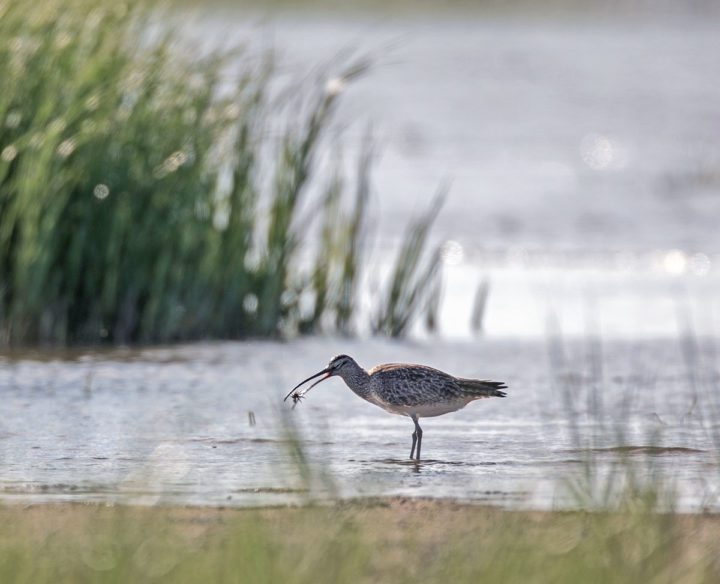
A Whimbrel eating a favorite food: a young fiddler crab. Photo by Andy Johnson.
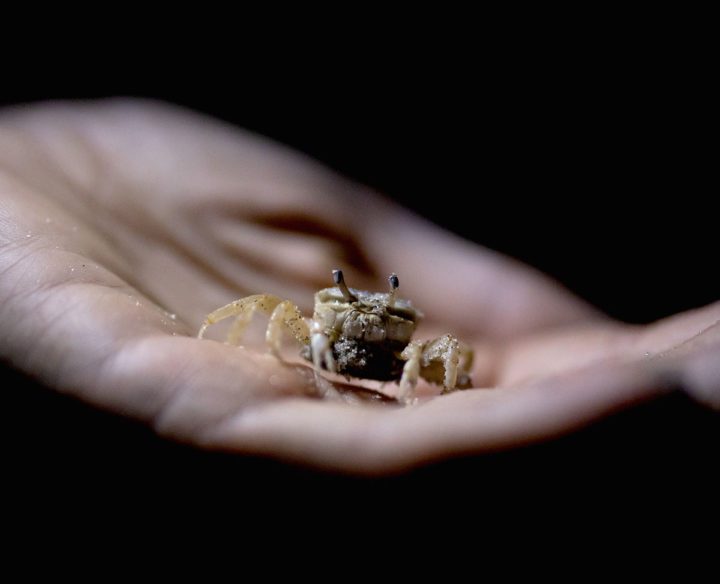
Close-up of a fiddler crab. Young crabs have yet to develop an enormous claw, making them easier prey. Photo by Andy Johnson.
Maina picked up what looked like a pork rind and proceeded to tell another unlikely story of Whimbrels regurgitating their stomach linings that she now held up for us to see. The innocuous shard of dried flesh would’ve been overlooked by 99% of ornithologists, but here, where Whimbrels had taken over the mind and heart spaces of a handful of deeply dedicated people, it was a wonder to behold. As we marveled over the treasure of a regurgitated gut filled with the remains of tiny crabs and bits of clamshell, Felicia was kneeling on the ground, her cheek on the sand.
“This definitely looks like the high spot,” she said. “What do y’all think?”
Felicia spoke with authority but was always democratically deferential about it. The crew nodded and meticulously cleared the sand of roots and grass stems that might alter the flight of the rocket net. “Can’t be too careful,” she said.
It was as if they were preparing to catch the last bird of a nearly gone species. And in some sense, this sentiment was warranted. Whimbrels and other curlews are declining precipitously. Populations of Whimbrels are essentially being halved decade by decade. Darkness was falling and the tide rapidly rose with it. I left the experts to their work and retreated to a spot where I’d be less likely to spook incoming birds. I felt helplessly free to just watch.
I was in a nearby place feeling very far away. I’ve been in Peruvian Amazon rainforest and Botswanan grass veldt. I’ve been beyond the Arctic Circle and in the Everglades grass sea. But never had I felt such a connection to wildness at home in South Carolina. As I pondered my fortune, and the sound and fury of thousands of nesting birds quieted to riotous with night falling, the first flocks of Whimbrels began to appear. We all quietly watched as 10 or 30 birds flew in loose knots to land on exposed flats on the far side of the mile-long island expanse. A few Whimbrel had come in close earlier, but now it seemed the switch had been thrown to open the spigot full-on. Flocks of tens became flocks of hundreds. The knots grew and untangled into skeins of birds stretched across the eventide. I wanted to stand and point—maybe shout out the incredulity of the numbers coming in—but mum was the operational word. Hundreds continued to come, and with them, the tide rose within inches of my sitting spot. There was little dry land left beyond what Felicia had side-eyed earlier. She’d been right about that, and the Whimbrel discovery that at first no one wanted to believe—except Andy.
A few minutes past sundown, a vermilion sliver appeared in the east. As it rose, a full moon that was supposed to be pink cast an almost indescribable red. The Whimbrels kept coming. Now there were flocks of a thousand rising up onto the face of the fresh-risen moon. Andy, camera rolling, couldn’t believe his luck. I tried phone shots first, then point-and-shoot camera with little luck. One of the DNR technicians who’d sat near me drawled, “Just watch with your eyes.”
“Oh my God, they’re still coming in!” said shorebird biologist Felicia Sanders as more Whimbrels poured into the roost in the fading light. Photo by Andy Johnson.
It was the best advice. Someone said they counted over 7,000 birds on the far end of the island. We confirmed “thousands” from where we sat watching. And the Whimbrels kept coming. Felicia and the crew retreated before the rising tide, surrendering any chance of netting birds that night as deepening water would foul the setups and the hazard of harm in any capture was too great. We gathered the equipment and headed back toward the boats. We’d been on Deveaux for more than six hours, but I’d lost all track of any time beyond dark and light and surging sea. As we motored back to Cherry Point, Felicia cut the engine to let the others catch up.
“Hear that?” she said, pointing back at the island. “Those are Whimbrel over there on that sandbar!” And just then, the telltale pipippipppi flight calls of birds turned us all to starboard.
“Oh my God, they’re still coming in!” she said.
For all of her work—the long hours of looking, losing time and fortune of the tide, for all that she’d discovered, she was learning more. We could barely see the Whimbrels, but heard what must have been another massive flock flying in. Exhaustion had set in for everyone but then the birds buoyed us beyond the late hour.
Back at the dock I thanked all I could before piling back into my pickup to head for the hotel. I stopped a couple of times on the Wadmalaw back roads to jot down something to capture what had just happened. It was hard to find words.
I’d gone from a boy wishing that Eskimo Curlews hadn’t been banished to Gone Bird status to become an ornithologist working on behalf of conservation. But in my 30 years in the field, there’d never been anything close to this serendipitous string. A chance meeting with a stranger that multiplied itself over six years into other meetings with strangers committed to a cause that went from several to several tens of thousands. That cause—confounded by a year of confusion, reconnected then to a visit that almost didn’t happen to a nearby faraway place I thought I knew but really didn’t—had warped so much of my sense of what I thought wildness was or what my reaction in it might be, that more than once I questioned reality.
With the birds and waxing ideas on what wildness really is, I mixed in thoughts of a place so ephemerally wild that it had likely not been tainted by the haints of enslavement that touched almost every other square foot of Lowcountry soil. It was an unlikely string of events I’d somehow managed to find myself connected to—or been connected to—by something beyond explanation.
Almost back to the hotel and sleeping, the four-letter code we ornithologists use for whimbrel hit me—WHIM.
Drew Lanham, PhD, is a conservation and cultural ornithologist at Clemson University. He is a lifelong birdwatcher and author of the award-winning memoir The Home Place —Memoirs of a Colored Man’s Love Affair with Nature (Milkweed 2016, Tantor Audio 2019) and Sparrow Envy—Field Guide to Birds and Lesser Beasts (Hub City 2021).
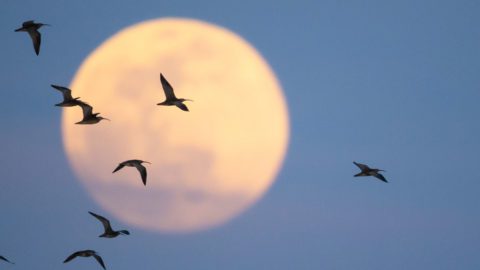
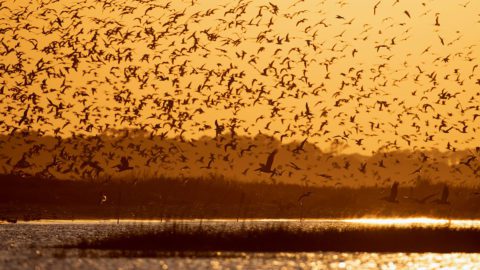
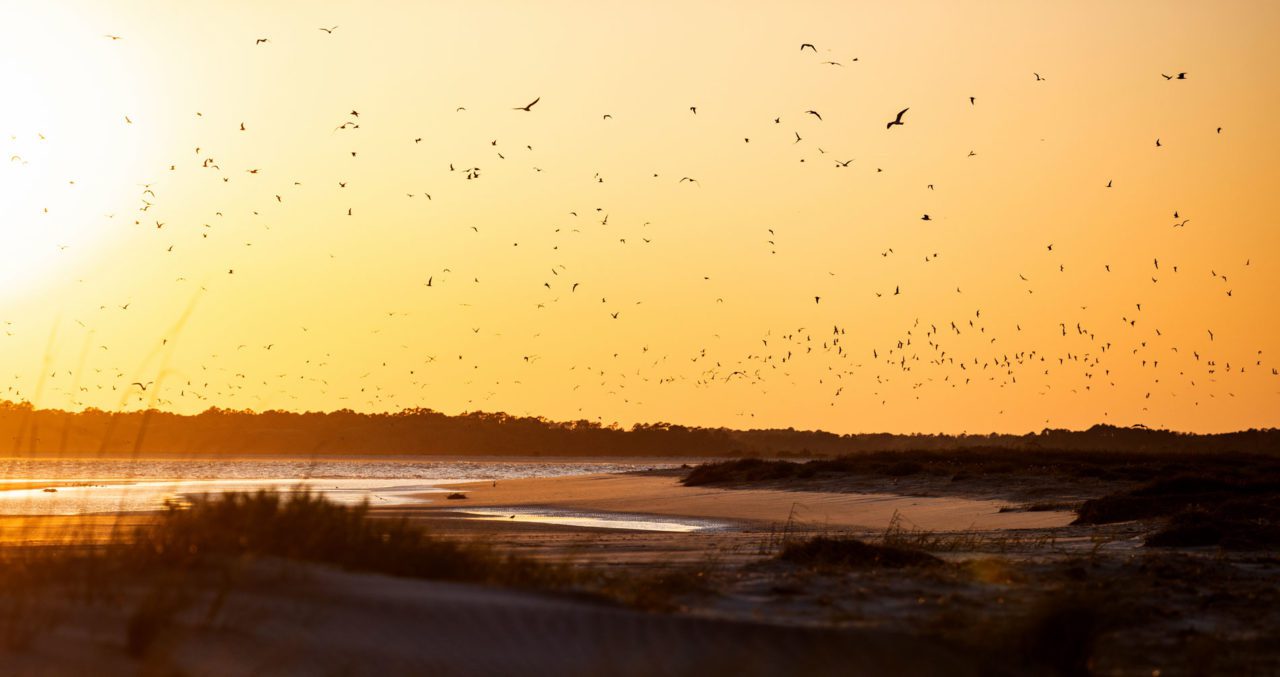
No comments:
Post a Comment